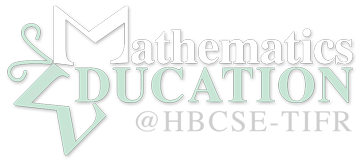Mathematics Laboratory
The mathematics laboratory is a place where anybody can experiment and explore patterns and ideas. It is a place where one can find a collection of games, puzzles, and other teaching and learning material. The materials are meant to be used both by the students on their own and with their teacher to explore the world of mathematics, to discover, to learn and to develop an interest in mathematics. The activities create interest among students or in anybody who wants to explore, and test some of their ideas, beliefs about mathematics.
To see list and details of the activities, use this link: Hands-on Mathematics Activities
The activities in the maths lab should be appealing to a wide range of people, of different ages and varying mathematical proficiency. While the initial appeal is broad-based, the level of engagement of different individuals may vary. The maths lab activities listed here have been done with students and teachers of different grade levels. The activities are intended to give children an experience of doing mathematics and not merely for the purpose of demonstration.
The maths lab provides an opportunity for the students to discover mathematics through doing. Many of the activities present a problem or a challenge, with the possibility of generating further challenges and problems. The activities help students to visualize, manipulate and reason. They provide opportunity to make conjectures and test them, and to generalize observed patterns. They create a context for students to attempt to prove their conjectures.
It is important to note that while in science experiments provide evidence for hypotheses or theories, this is not so in mathematics. Observed patterns can only suggest mathematical hypotheses and conjectures, not provide evidence to support them. (Sometimes, they may help to disprove a conjecture through a counter-example.) Mathematical truths are accepted only on the basis of proofs, and not through experiment.
Mathematics laboratory is a place to enjoy mathematics through informal exploration. It is a place where anyone can generate problems and struggle to get a answer. It is a space to explore and design new mathematical activities. So, the maths lab should not be used to assess students’ knowledge of mathematics. Often mathematics lab takes students knowledge beyond the curriculum.
Mathematics laboratory is a self-explanatory lab with activities, in which students could come anytime (free to them) and engage in the work, continue working on the problems/tasks, and use teachers as and when they are stuck. In this way, the role of the teacher is not to teach how to progress in the activity but to facilitate inquiry with the mathematics in it. The facilitation could be done either by probing questions, giving an extra resource or asking to follow or discuss with peers.
Mathematics Laboratory Manual
In this report we have described some activities which could typically be included in a school mathematics laboratory. The activities are suitable for students of class 6 to class 10. We have also included a couple of activities suitable for a lower level — the place-value snake and the fraction chart. The items have been grouped under two broad headings: (i) activities and (ii) games and puzzles. The activities could be done individually by students, with guidance from a teacher, or could be used for demonstration with a small group of students. Some of the activities could also be used as teaching aids in a classroom. The games and puzzles are fun to do individually and all of them contain some element of mathematics which can be explored while doing them or as a sequel. Some of these items have been developed by the authors at HBCSE. Others have been taken from articles and books and have been modified or developed further.
Download pdf version in English
Download pdf version in Marathi
